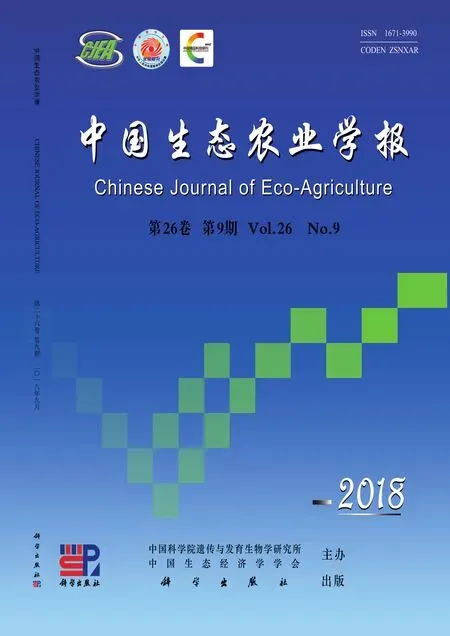市域尺度两种生态系统服务评价方法对比研究*
刘世梁, 赵 爽, 成方妍, 侯笑云, 贾克敬, 祁 帆, 杨 枫
市域尺度两种生态系统服务评价方法对比研究*
刘世梁1, 赵 爽1, 成方妍1, 侯笑云1, 贾克敬2, 祁 帆2, 杨 枫2
(1. 北京师范大学环境学院水环境模拟国家重点实验室 北京 100875; 2. 中国土地勘测规划院 北京 100875)
生态保护红线的划定对于规范人类活动、控制人类活动强度、维护生态安全和保护生态系统功能的可持续性具有重要意义, 生态系统服务评价是其中重要的一环。由于我国地域面积广阔、地形地貌特征多样、区域自然状况复杂多变, 因此环境保护部于2015年出台的《生态保护红线划定技术指南》中有两种生态系统服务评价的方法, 即NPP定量指标法和模型评价法。本研究基于MODIS遥感影像, 利用NPP定量指标法对鹤壁市生态系统服务进行评价, 并与模型评价法进行比较, 为选取更为适合该区域的评价方法, 及较小尺度的生态保护红线的划定提供理论依据。结果表明在市域尺度上, NPP定量指标法和模型评价法的评价结果之间存在显著差异。模型评价法对鹤壁市生态系统服务(水土保持功能和生物多样性保护功能)的高评价区域与生态保护现状较好的区域更为一致(面积重叠比例分别为19%和85%), 而NPP定量指标法的评价结果与保护现状并不一致。相对于NPP定量指标法, 模型评价法更适合对该研究区域的生态系统服务进行评价。因此在以后的研究中, 应结合研究区域的实际情况, 选取适当的方法进行生态系统服务评价。本研究的对比分析可为市域尺度的生态系统服务评价及生态保护红线的划定提供参考。
生态系统服务; 模型评价法; NPP定量指标法; 生态保护红线; 鹤壁市
生态环境部发布的《生态保护红线划定技术指南》规范了我国境内生态保护红线的划定工作, 其中提出, 在重点生态功能区、生态环境敏感区和生态环境脆弱区等区域, 依法划定生态保护红线的严格管控边界, 用以维护国家和区域的生态安全。生态保护红线的划定有利于降低人类活动对生态环境的干扰、保护人类的生产生活、实现可持续发展[1]。
我国已经开展了国家尺度的生态保护红线划定工作, 各省级生态保护红线的划定也接近完成, 目前市域尺度的生态保护红线试点划定工作正在开展或者启动[2-3]。但在生态保护红线的划定过程中, 存在分级困难、指标多样化、尺度难确定、评价方法众多等问题[4]。其中, 关键因素之一是区域的生态系统服务评价。生态系统服务是指人类从生态系统中获得的效益[5-6],是人类生存与现代文明的基础[7]。但由于人类对生态系统服务及其重要性的忽视, 导致了生态环境的破坏, 从而对生态系统服务造成了严重的损害, 威胁着人类的安全与可持续发展[8], 因此开展生态系统服务评价十分必要[9-10]。生态系统服务评价是针对区域典型生态系统, 评价其生态系统服务的综合特征,目的是在人类发展的同时, 实现生态系统的良性循环[11]。在评价生态系统服务时, 研究尺度和评价方法的选择是两大难点[12-13]。
生态系统可在不同的空间尺度上进行定义, 因此对于其服务的评价尺度的选择也多种多样[14]。目前我国已经在较大尺度上对城市[15-16]、自然保护区[17-18]、森林[19-20]、湿地[21-22]、农田[23-24]、喀斯特地貌区[25]、水库[26-27]等进行了生态系统服务的评价, 划定了部分生态系统服务重要区域[28], 对受到威胁或破坏的重要生态系统开展了一定的保护性工作[29], 用以维持生态系统的稳定, 实行可持续的发展战略。但较大尺度的生态系统服务评价, 在评价的过程中降低了数据的准确性, 使其无法应用于较小尺度。为了更为合理地划定较小尺度的生态保护红线, 有必要在较小尺度上进行生态系统服务评价的研究, 且中、小尺度上的研究, 更加精确受保护地的覆盖范围, 可以为大尺度上的保护工作提供基础数据[30]。
评价方法的选择是进行生态系统服务评价的前提, 因而得到了较为广泛的研究[31-32]。赵小汎[33]分别使用Costanza评价方法和谢高地评价方法对辽宁省生态服务价值进行估算, 结果显示谢高地评价方法得出的数值更为符合辽宁省的实际情况, 证明了评价方法具有一定地域适宜性。
本文在市域尺度上, 选取河南省鹤壁市为案例区,以《生态保护红线划定技术指南》为基础,对比模型评价法和NPP定量指标法的评价结果,选取更为适合该区域的评价方法,为较小尺度生态保护红线的划定提供理论依据。
1 材料与方法
1.1 研究区概况
研究区鹤壁市位于太行山东麓向华北平原的过渡地带(35°26′~36°02′N, 113°59′~114°45′E), 属于暖温带半湿润型季风气候, 市土地面积共计2 182 km2[34]。年均气温14.2~15.5 ℃,年降水量349.2~970.1 mm, 春季多风少雨, 夏季湿润炎热, 秋季秋高气爽, 冬季寒冷多雾, 四季较为分明。境内有羑河、汤河和淇河3条主要河流, 孕育了古老的朝歌文化。鹤壁市的中东部地区多为平原(图1), 人为活动对生态环境的影响较为严重, 因此西部山区的生态保护作用就显得更为重要。
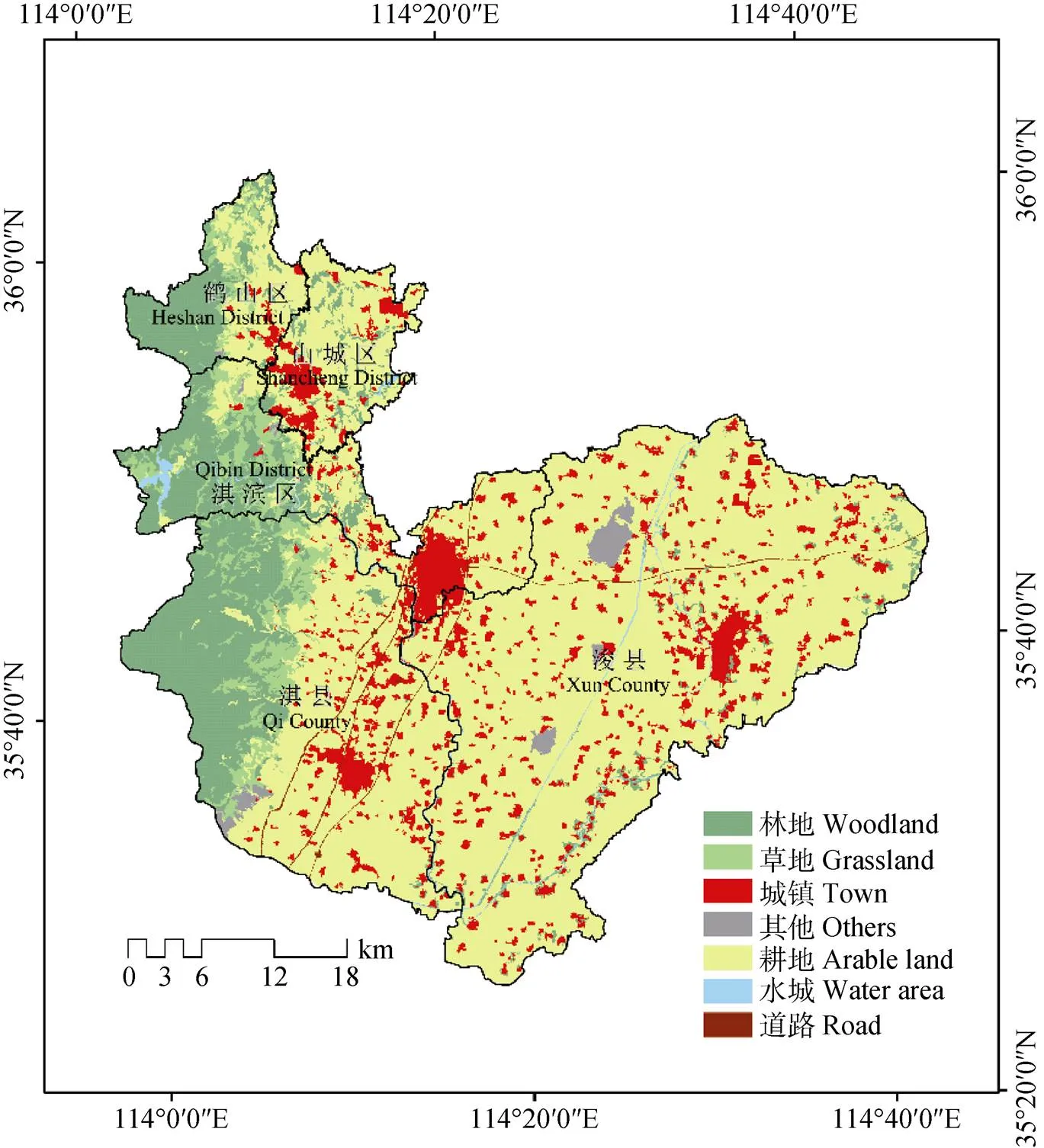
图1 研究区鹤壁市土地利用图
1.2 评价指标体系的构建
1.2.1 评价指标体系的构成
准确评价鹤壁市的生态系统服务, 可以为鹤壁市生态保护红线的划定奠定基础。本研究采用NPP定量指标法和模型评价法对鹤壁市的水源涵养功能、水土保持功能、生物多样性保护功能进行评价, 数据来源及评价方法详见表1和表2。其中气象数据的获取, 是通过计算鹤壁市周围地区气象站点全年的数据, 使用克里金插值法得到整个区域的数据。由于数据的来源不同, 具体的参数计算方法也不同, 因此得到的各个结果的分辨率也不一致, 因而本研究在最后进行图层叠加时, 将参数统一分辨率为300 m。
1.2.2 标准化方法
采用离差标准化对原始数据进行线性变换, 使结果值映射至[0, 1]。转换公式为:
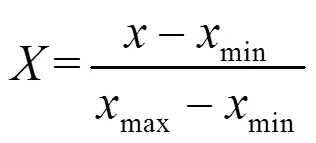
式中:max为样本数据的最大值,min为样本数据的最小值。
2 结果与分析
2.1 两种评价方法结果的空间差异对比分析
NPP定量指标法对鹤壁市水源涵养功能的评价结果见图2A。其中, 水源涵养功能高的区域多分布于中部和东部, 西部的水源涵养功能则相对较弱。在不同行政区内, 高的水源涵养功能区主要分布在浚县, 而鹤山区、山城区和淇滨区的水源涵养功能则整体较弱。模型评价法的评价结果从整体上来看(图2B), 水源涵养功能高的区域多分布于南部地区(浚县和淇县), 北部地区的水源涵养功能则相对较弱。

表1 评价指标体系的基础数据名称、内容及来源
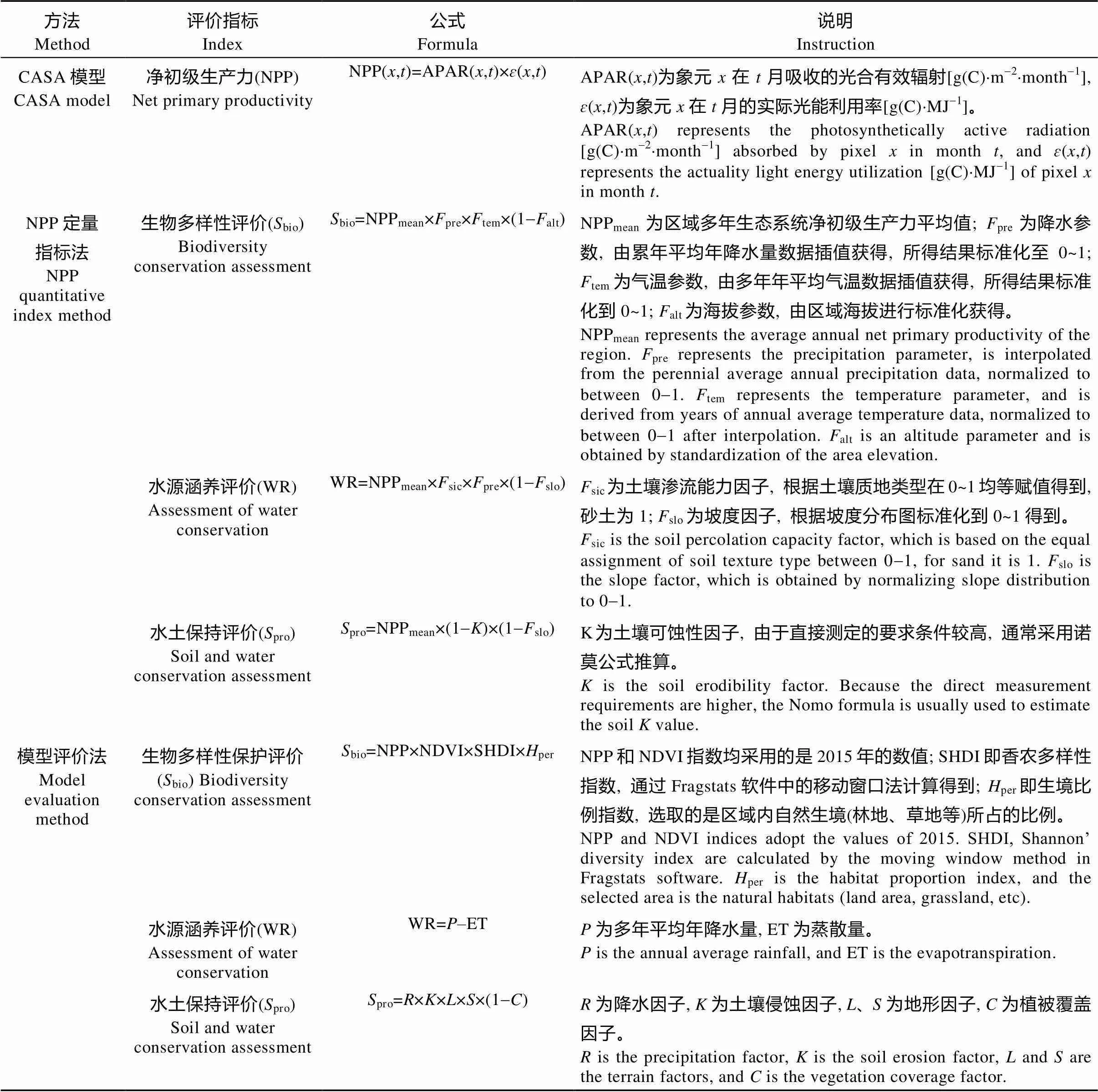
表2 不同生态系统服务评价方法的指标体系说明
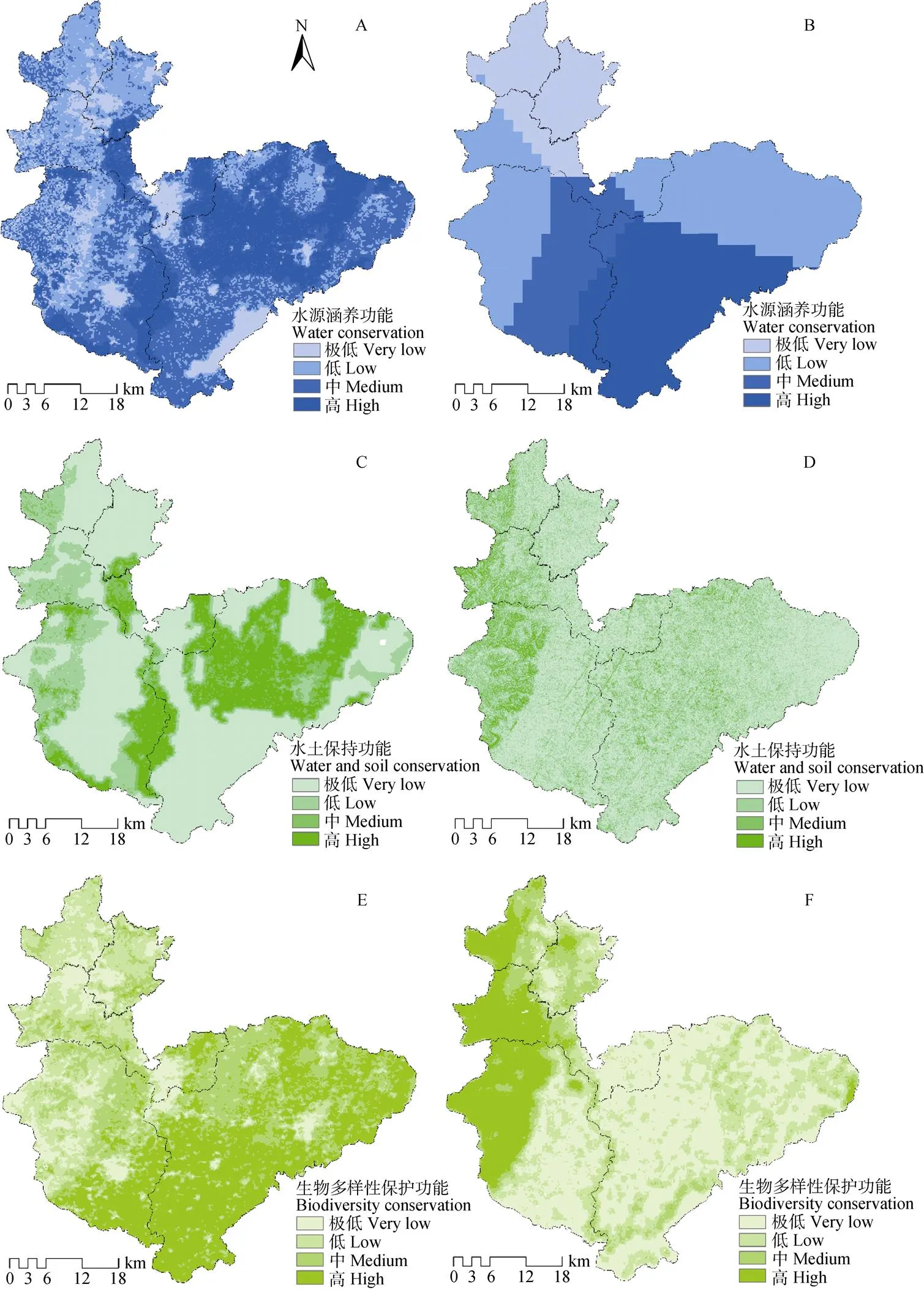
图2 NPP定量指标法(A, C, E)和模型评价法(B, D, F)对2015年鹤壁市生态系统水源涵养功能(A, B)、水土保持功能(C, D)和生物多样性保护功能(E, F)的评价结果
NPP定量指标法的水土保持功能评价结果不同区域之间的分布差异较大(图2C)。东部既有大量的水土保持功能高评价区, 也存在大量水土保持功能较弱的区域。在不同行政区内, 浚县既有大量的水土保持功能高评价区域, 也存在大量的水土保持较低的区域。而在鹤山区、山城区、淇滨区和淇县, 水土保持功能分布相对多样, 主要为中和低的水土保持功能区。模型评价法的评价结果如图2D所示, 鹤壁市水土保持功能高评价区主要分布在西部山区。从不同行政区划来看, 浚县水土保持功能高的区域分布较为分散, 同时存在大量的水土保持低或极低的区域。而在鹤山区、淇滨区和淇县, 水土保持功能高评价区域的分布则较为集中。
NPP定量指标法将NPP、平均降水量、平均气温和海拔4个指标的数值进行叠加, 而模型评价法则考虑NDVI、SHDI、Hper和NPP数值进行叠加, 用以分析鹤壁市生物多样性保护功能的空间分布。结果显示NPP定量指标评价法的高评价地区主要分布于鹤壁市南部(图2E), 中评价地区主要分布于鹤壁市东部。模型评价法的评价结果与NPP定量指标法的评价结果基本相反(图2F), 即高和中评价地区主要分布在西部山区、淇河流域和卫河流域。
2.2 两种评价结果与保护现状的对比分析
由于森林生态系统的水源涵养功能、水土保持功能和生物多样性保护功能均较高[35], 本文以鹤壁市省级以上的森林公园(森林公园是研究区域内主要的森林生态系统的保护区域, 即在森林公园的分布范围内, 具有较高的水源涵养功能、水土保持功能和生物多样性保护功能)的分布范围为依据(图3), 对比分析两种不同评价方法的结果与现状的差异。
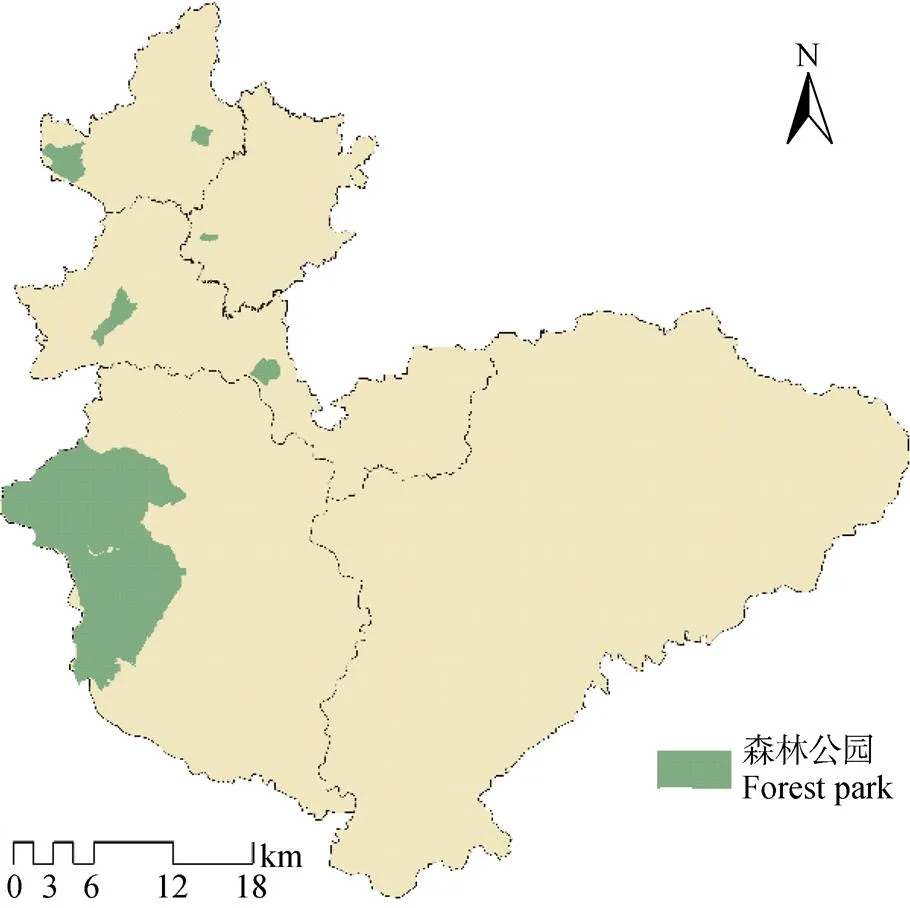
图3 鹤壁市森林公园分布图
由表3可知, 相对于NPP定量指标法的评价结果, 模型评价法对水土保持功能和生物多样性保护功能的评价较为准确。而两种方法对于水源涵养功能的评价均不准确。通过对比分析, 认为模型评价法更适合对研究区的生态系统服务进行评价。
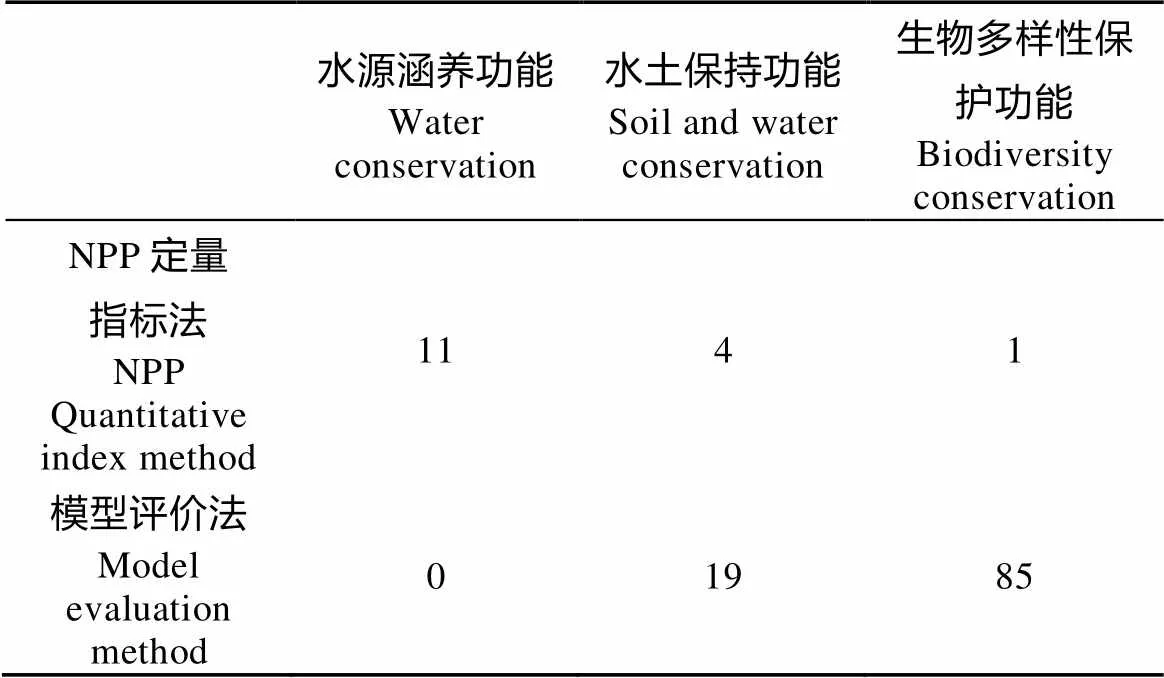
表3 两种评价方法的高评价区域与森林公园的重叠比例
3 讨论
由于目前存在多种生态系统服务评价方法, 且不同的评价方法适用于不同的区域[33], 为了更为准确地评价河南省鹤壁市的生态系统服务, 本研究通过采用两种常用的生态系统服务评价方法, 对比两种评价方法对鹤壁市生态系统服务(水源涵养功能、水土保持功能和生物多样性保护功能)的评价结果, 并以鹤壁市省级以上森林公园的分布区域为基础, 筛选评价结果更为准确的评价方法。
基于两种方法的评价结果, 并将其与森林公园的分布范围对比可知, 相对于NPP定量指标法, 模型评价法对研究区生态系统服务的评价结果更符合实际状况。这是由于在NPP定量指标法的评价公式中, 生物多样性保护的重要性主要受到海拔和NPPmean结果的影响(降水和温度在市域尺度差别并不大)。鹤壁市作为农业大市, 其东部地区多为农业区, 该区域的NPPmean结果与西部山区的NPPmean结果差异不大, 因此最终的生物多样性保护功能的评价结果主要由海拔决定, 即海拔越高的地区生物多样性保护的重要性分级越低, 而海拔越低的地区反而分级越高, 这就导致鹤壁市西部山区的生物多样性保护功能的评价较低, 与实际状况不符(西部山区广泛分布着公益林、水库和森林公园, 拥有较高的水源涵养功能、水土保持功能和生物多样性保护功能)。水源涵养功能和水土保持功能的评价结果也是如此, 由坡度决定, 且与坡度呈反比, 而西部山区的坡度显然较东部平原地区大, 加之土壤渗流等的评价结果, 则可以得出西部山区的水源涵养功能和水土保持功能较低。综上可知, NPP定量指标法不适宜作为鹤壁市生态系统服务评价的方法。但并不代表NPP定量指标法不适用于其他的区域, 王丽霞等[36]采用NPP定量指标法对北京市昌平区生态系统服务功能进行评价, 结果显示, 相对于东南的平原区域, 西北部山区的水源涵养功能、水土保持功能和生物多样性保护功能较高, 符合昌平区的实际状况, 证明NPP定量指标法适合对该地区进行生态系统服务评价。该研究结果与本研究结果相反, 是由于昌平区的山区NPPmean评价较高, 但平原区以城市为主(鹤壁市以农业为主), NPPmean评价较低。因此, 虽然NPP定量指标法的评价结果与海拔、坡度呈反比, 但山区较高的NPPmean评价结果决定了区域整体的评价结果。
模型评价法对生物多样性保护功能的评价结果较为准确, 这是由于公式中所考虑的指标(NPP, NDVI, Hper)分布与森林公园的分布较为契合, 即均呈西高东低之势。虽然鹤壁市的东部植被覆盖因子评价结果较高, 但东部地区多为耕地, 其水土保持能力远不如西部山区的落叶阔叶林带, 因此水土保持功能的评价结果也较为符合实际情况。但水源涵养功能的评价不准确, 是由于鹤壁市的降水呈现由东南向西北递减的趋势, 且评价公式并未考虑下垫面的情况, 因此西部山区的水源涵养评价结果偏低。
通过对比两种评价方法的结果及其与鹤壁市森林公园的空间分布差异, 研究认为在选择适宜的评价方法时, 应注意以下3个方面: 1)深入了解不同评价方法所选择的评价参数, 筛选适合研究区的评价参数; 2)对比评价结果与实际受保护区域的空间分布差异, 从而选择合适的评价方法; 3)若由于特殊的气候、地形、地貌等因素, 无较为适宜的评价方法时, 则应对部分区域的评价参数进行加权。
4 结论
研究采用两种不同的生态系统服务评价方法, 分别对鹤壁市的水源涵养功能、水土保持功能和生物多样性保护功能进行评价。在与鹤壁市省级以上森林公园的分布范围进行叠加分析的基础上, 对比了两种评价方法的评价结果, 进而得出模型评价法更为适合作为研究区内生态系统服务的评价方法。但该结果并不能说明NPP定量指标法不适用于其他地区,而是不同的方法适用于不同的地区, 以及不同的尺度。因此, 在将来的生态系统服务评价研究中, 应结合研究区域的实际情况, 选取适合该区域的评价方法, 力求使评价结果更为详实可靠, 为当地的生态系统管理与可持续发展提供一定的理论依据。
[1] 姚佳, 王敏, 黄宇驰, 等. 我国生态保护红线三维制度体系——以宁德市为例[J]. 生态学报, 2015, 35(20): 6848−6856 YAO J, WANG M, HUANG Y C, et al. Three-dimensional frame exploration of the ecological protection red line in China: A case study of the Ningde Region[J]. Acta Ecologica Sinica, 2015, 35(20): 6848−6856
[2] 林勇, 樊景凤, 温泉, 等. 生态红线划分的理论和技术[J]. 生态学报, 2016, 36(5): 1244−1252 LIN Y, FAN J F, WEN Q, et al. Primary exploration of ecological theories and technologies for delineation of ecological redline zones[J]. Acta Ecologica Sinica, 2016, 36(5): 1244−1252
[3] 黎斌, 何建华, 屈赛, 等. 基于贝叶斯网络的城市生态红线划定方法[J]. 生态学报, 2018, 38(3): 800−811 LI B, HE J H, QU S, et al. A method of delimiting urban ecological red line protection area based on Bayesian network[J]. Acta Ecologica Sinica, 2018, 38(3): 800−811
[4] 蒋大林, 曹晓峰, 匡鸿海, 等. 生态保护红线及其划定关键问题浅析[J]. 资源科学, 2015, 37(9): 1755−1764 JIANG D L, CAO X F, KUANG H H, et al. Ecological red line planning and related key issues analysis for China[J]. Resources Science, 2015, 37(9): 1755−1764
[5] 傅伯杰, 周国逸, 白永飞, 等. 中国主要陆地生态系统服务功能与生态安全[J]. 地球科学进展, 2009, 24(6): 571−576 FU B J, ZHOU G Y, BAI Y F, et al. The main terrestrial ecosystem services and ecological security in China[J]. Advances in Earth Science, 2009, 24(6): 571−576
[6] MAITRE D C L, MILTON S J, JARMAIN C. Linking ecosystem services and water resources: Landscape-scale hydrology of the Little Karoo[J]. Frontiers in Ecology and the Environment, 2007, 5(5): 261−270
[7] 郑华, 李屹峰, 欧阳志云, 等. 生态系统服务功能管理研究进展[J]. 生态学报, 2013, 33(3): 702−710 ZHENG H, LI Y F, OUYANG Z Y, et al. Progress and perspectives of ecosystem services management[J]. Acta Ecologica Sinica, 2013, 33(3): 702−710
[8] 张琨, 吕一河, 傅伯杰. 黄土高原典型区植被恢复及其对生态系统服务的影响[J]. 生态与农村环境学报, 2017, 33(1): 23−31 ZHANG K, LYU Y H, FU B J. Vegetation restoration and its influences on ecosystem services in areas typical of the Loess Plateau[J]. Journal of Ecology and Rural Environment, 2017, 33(1): 23−31
[9] 杨旭, 沈珍, 闵水发, 等. 生态系统服务研究进展[J]. 中国农学通报, 2015, 31(35): 133−138 YANG X, SHEN Z, MIN S F, et al. Ecosystem services: A review[J]. Chinese Agricultural Science Bulletin, 2015, 31(35): 133−138
[10] PIMM S L, JENKINS C N, ABELL R, et al. The biodiversity of species and their rates of extinction, distribution, and protection[J]. Science, 2014, 344(6187): 987
[11] 肖强, 肖洋, 欧阳志云, 等. 重庆市森林生态系统服务功能价值评估[J]. 生态学报, 2014, 34(1): 216−223 XIAO Q, XIAO Y, OUYANG Z Y, et al. Value assessment of the function of the forest ecosystem services in Chongqing[J]. Acta Ecologica Sinica, 2014, 34(1): 216−223
[12] BURKHARD B, KROLL F, NEDKOV S, et al. Mapping ecosystem service supply, demand and budgets[J]. Ecological Indicators, 2012, 21: 17−29
[13] CROSSMAN N D, BURKHARD B, NEDKOV S, et al. A blueprint for mapping and modeling ecosystem services[J]. Ecosystem Services, 2013, 4: 4−14
[14] 张宏锋, 欧阳志云, 郑华. 生态系统服务功能的空间尺度特征[J]. 生态学杂志, 2007, 26(9): 1432−1437 ZHANG H F, OUYANG Z Y, ZHENG H. Spatial scale characteristics of ecosystem services[J]. Chinese Journal of Ecology, 2007, 26(9): 1432−1437
[15] 王宽, 蔡正华, 齐增湘, 等. 2000—2013年衡阳市土地利用格局转变对生态系统服务的影响[J]. 中国生态农业学报, 2017, 25(7): 1060−1070 WANG K, CAI Z H, QI Z X, et al. Effect of land use transformation pattern in 2000–2013 on ecosystem services in Hengyang City, China[J]. Chinese Journal of Eco-Agriculture, 2017, 25(7): 1060–1070
[16] 李晓赛, 朱永明, 赵丽, 等. 基于价值系数动态调整的青龙县生态系统服务价值变化研究[J]. 中国生态农业学报, 2015, 23(3): 373–381 LI X S, ZHU Y M, ZHAO L, et al. Ecosystem services value change in Qinglong County from dynamically adjusted value coefficients[J]. Chinese Journal of Eco-Agriculture, 2015, 23(3): 373–381
[17] 焦亮, 赵成章. 祁连山国家自然保护区山丹马场草地生态系统服务功能价值分析及评价[J]. 干旱区资源与环境, 2013, 27(12): 47−52 JIAO L, ZHAO C Z. The analysis and evaluation on grassland ecosystem service function value of Shandan Horse Field in Qilian Mountain National Nature Reserve[J]. Journal of Arid Land Resources and Environment, 2013, 27(12): 47−52
[18] 肖燚, 陈圣宾, 张路, 等. 基于生态系统服务的海南岛自然保护区体系规划[J]. 生态学报, 2011, 31(24): 7357−7369 XIAO Y, CHEN S B, ZHANG L, et al. Designing nature reserve systems based on ecosystem services in Hainan Island[J]. Acta Ecologica Sinica, 2011, 31(24): 7357−7369
[19] 冯继广, 丁陆彬, 王景升, 等. 基于案例的中国森林生态系统服务功能评价[J]. 应用生态学报, 2016, 27(5): 1375−1382 FENG J G, DING L B, WANG J S, et al. Case-based evaluation of forest ecosystem service function in China[J]. Chinese Journal of Applied Ecology, 2016, 27(5): 1375−1382
[20] 石小亮, 陈珂, 揭昌亮, 等. 吉林省森林生态系统服务价值评价[J]. 水土保持通报, 2016, 36(5): 312−319 SHI X L, CHEN K, JIE C L, et al. Evaluation on service value of forest ecosystem in Jilin Province[J]. Bulletin of Soil and Water Conservation, 2016, 36(5): 312−319
[21] 庞丙亮, 崔丽娟, 马牧源, 等. 若尔盖高寒湿地生态系统服务价值评价[J]. 湿地科学, 2014, 12(3): 273−278 PANG B L, CUI L J, MA M Y, et al. Evaluation of ecosystem services valuation of Alpine Wetlands in Zoigê Plateau[J]. Wetland Science, 2014, 12(3): 273−278
[22] 江波, 欧阳志云, 苗鸿, 等. 海河流域湿地生态系统服务功能价值评价[J]. 生态学报, 2011, 31(8): 2236−2244 JIANG B, OUYANG Z Y, MIAO H, et al. Ecosystem services valuation of the Haihe River Basin Wetlands[J]. Acta Ecologica Sinica, 2011, 31(8): 2236−2244
[23] 肖玉, 谢高地, 安凯, 等. 华北平原小麦−玉米农田生态系统服务评价[J]. 中国生态农业学报, 2011, 19(2): 429−435 XIAO Y, XIE G D, AN K, et al. Ecosystem services of wheat-maize cropland systems in the North China Plain[J]. Chinese Journal of Eco-Agriculture, 2011, 19(2): 429−435
[24] 杨正勇, 杨怀宇, 郭宗香. 农业生态系统服务价值评估研究进展[J]. 中国生态农业学报, 2009, 17(5): 1045−1050 YANG Z Y, YANG H Y, GUO Z X. A literature review on evaluation of agricultural ecosystem services[J]. Chinese Journal of Eco-Agriculture, 2009, 17(5): 1045−1050
[25] 高渐飞, 熊康宁. 喀斯特石漠化生态系统服务价值对生态治理的响应——以贵州花江峡谷石漠化治理示范区为例[J]. 中国生态农业学报, 2015, 23(6): 775–784 GAO J F, XIONG K N. Ecosystem service value responses to ecological control in Karst region —A case study of Huajiang gorge demonstration area of rocky desertification control in Guizhou[J]. Chinese Journal of Eco-Agriculture, 2015, 23(6): 775–784
[26] 刘晓娜, 张微微, 李红. 基于LUCC的密云水库上游流域人为干扰动态变化[J]. 生态与农村环境学报, 2016, 32(6): 951–957 LIU X N, ZHANG W W, LI H. Research on dynamics of human disturbance in upper streams of Miyun Reservoir Watershed based on land use and land cover change[J]. Journal of Ecology and Rural Environment, 2016, 32(6): 951–957
[27] 郭晓娜, 苏维词, 李强, 等. 三峡库区(重庆段)地表起伏度及其对生态系统服务价值的影响[J]. 生态与农村环境学报, 2016, 32(6): 887−894 GUO X N, SU W C, LI Q, et al. Surface relief degree and its effects on ecosystem service value in the Chongqing section of the Three Gorges Reservoir Region, China[J]. Journal of Ecology and Rural Environment, 2016, 32(6): 887−894
[28] 张立伟, 傅伯杰, 吕一河, 等. 基于综合指标法的中国生态系统服务保护有效性评价研究[J]. 地理学报, 2016, 71(5): 768−780ZHANG L W, FU B J, LYU Y H, et al. The using of composite indicators to assess the conservational effectiveness of ecosystem services in China[J]. Acta Geographica Sinica, 2016, 71(5): 768−780
[29] 徐卫华, 欧阳志云, 黄璜, 等. 中国陆地优先保护生态系统分析[J]. 生态学报, 2006, 26(1): 271−280 XU W H, OUYANG Z Y, HUANG H, et al. Priority analysis on conserving China’s terrestrial ecosystems[J]. Acta Ecologica Sinica, 2006, 26(1): 271−280
[30] 赵富伟, 武建勇, 薛达元.《生物多样性公约》传统知识议题的背景、进展与趋势[J]. 生物多样性, 2013, 21(2): 232−237 ZHAO F W, WU J Y, XUE D Y. Background, progress and prospect of traditional knowledge under the convention on biological diversity[J]. Biodiversity Science, 2013, 21(2): 232−237
[31] 吕一河, 张立伟, 王江磊. 生态系统及其服务保护评估: 指标与方法[J]. 应用生态学报, 2013, 24(5): 1237−1243LYU Y H, ZHANG L W, WANG J L. Assessment of ecosystem and its services conservation: Indicators and methods[J]. Chinese Journal of Applied Ecology, 2013, 24(5): 1237−1243
[32] COWLING R M, EGOH B, KNIGHT A T, et al. An operational model for mainstreaming ecosystem services for implementation[J]. Proceedings of the National Academy of Sciences of the United States of America, 2008, 105(28): 9483−9488
[33] 赵小汎. 土地利用生态服务价值指标体系评估结果比较研究[J]. 长江流域资源与环境, 2016, 25(1): 98−105 ZHAO X F. Comparison on evaluation result and index system of ecosystem service values based on land use[J]. Resources and Environment in the Yangtze Basin, 2016, 25(1): 98−105
[34] 张健, 田国行. 基于生态足迹法的鹤壁市可持续发展探讨[J]. 河南农业大学学报, 2012, 46(1): 85−91 ZHANG J, TIAN G X. Ecological footprint based analysis of sustainable development of Hebi City[J]. Journal of Henan Agricultural University, 2012, 46(1): 85−91
[35] 徐雨晴, 周波涛, 於琍, 等. 气候变化背景下中国未来森林生态系统服务价值的时空特征[J]. 生态学报, 2018, 38(6): 1952−1963 XU Y Q, ZHOU B T, YU L, et al. Temporal-spatial dynamic pattern of forest ecosystem service value affected by climate change in the future in China[J]. Acta Ecologica Sinica, 2018, 38(6): 1952−1963
[36] 王丽霞, 邹长新, 王燕, 等. 基于GIS识别生态保护红线边界的方法——以北京市昌平区为例[J]. 生态学报, 2017, 37(18): 6176−6185 WANG L X, ZOU C X, WANG Y, et al. Methods to identify the boundary of ecological protection red line regions using GIS: A case study in Changping, Beijing[J]. Acta Ecologica Sinica, 2017, 37(18): 6176−6185
Comparative study on two evaluating methods of ecosystem services at city-scale*
LIU Shiliang1, ZHAO Shuang1, CHENG Fangyan1, HOU Xiaoyun1, JIA Kejing2, QI Fan2, YANG Feng2
(1. State Key Laboratory of Water Environment Simulation, School of Environment, Beijing Normal University, Beijing 100875, China; 2. China Land Surveying and Planning Institute, Beijing 100875, China)
The red line of ecological protection is significance in controlling the intensity of human activity and in maintaining ecological security and sustainability. China has already carried out a demarcation work of red line for ecological protection at national scale and is now nearing completion at provincial scale. Also the demarcation of red line for ecological protection at municipal scale is underway. However, in the process of delineating the red line for ecological protection, problems such as difficulty in classification, diversification of indicators, determination of scale and selection of evaluation methods have been encountered. The evaluation of ecosystem services is one important step in delineating red lines. Ecosystem service refers to any benefit that mankind can obtain from the ecosystem and it is the basis of human survival and modern civilization. Human neglect of ecosystem services and their importance has caused serious damage to critical natural ecosystems. Therefore, it is necessary to carry out an evaluation of ecosystem services. To standardize the evaluation of ecosystem services in China, the Technical Guidelines for the delineation of red lines for ecological protection issued by the Ministry of Ecology and Environment recommended the NPP quantitative index method and the model evaluation method to evaluate ecosystem services. As China has wide geographical extent with complex topographic features and natural conditions, it is important to evaluate the suitability of the two methods for application in demarcating red lines for ecological service evaluation. Based on MODIS remote sensing images, the evaluation of ecosystem services in Hebi City was carried out using the NPP quantitative index method and compared with the model evaluation method. The purpose of the paper was to select a more suitable evaluation method for the area and to provide theoretical basis for the demarcation of red line for ecological protection smaller-scale. In this study, we compared the results of the ecosystem service evaluation derived from the two different methods. The results showed that there was a significant difference between the NPP quantitative index method and the model evaluation method at prefectural city scale. In order to judge which method was more accurate, we compared the results of the two evaluation methods in terms of spatial distribution of the forest park. The model evaluation method was more consistent for high evaluation area of ecosystem services (soil and water conservation functions and biodiversity protection function) and the area with better ecological protection (area overlapping ratios of 19% and 85%, respectively) in Hebi City. The evaluation result of the NPP quantitative index method was not consistent with the protection status. The reason why the NPP quantitative index method was inaccurate was that the selected parameters and calculation formulas were not suitable for the study area. Therefore, the model evaluation method was more accurate for evaluating ecosystem services in the study area, compared with the NPP quantitative index method at prefectural city scale. Appropriate method should be selected according to actual local conditions in order to accurately evaluate ecosystem services in future studies. The comparative analysis in this study provided a reference point for evaluating ecosystem services and delineating red lines for ecological protection.
Ecosystem service; Model evaluation method; NPP quantitative index method; Ecological protection red line; Hebi City
, LIU Shiliang, E-mail: shiliangliu@bnu.edu.cn
Dec. 29, 2017;
May 10, 2018
10.13930/j.cnki.cjea.171159
X321
A
1671-3990(2018)09-1315-09
2017-12-29
2018-05-10
* This study was supported by the National Key Research and Development Project of China (2016YFC0502103) and the National Natural Science Foundation of China (41571173).
* 国家重点研发计划项目(2016YFC0502103)和国家自然科学基金面上项目(41571173)资助
刘世梁, 主要研究方向为景观生态学。E-mail: shiliangliu@bnu.edu.cn
刘世梁, 赵爽, 成方妍, 侯笑云, 贾克敬, 祁帆, 杨枫. 市域尺度两种生态系统服务评价方法对比研究[J]. 中国生态农业学报, 2018, 26(9): 1315-1323
LIU S L, ZHAO S, CHENG F Y, HOU X Y, JIA K J, QI F, YANG F. Comparative study on two evaluating methods of ecosystem services at city-scale[J]. Chinese Journal of Eco-Agriculture, 2018, 26(9): 1315-1323

